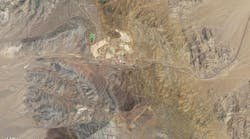Surging rare-earth production in China is presenting a new challenge to budding efforts in the U.S. and elsewhere to undercut the Asian giant’s dominance in a market for exotic materials used in everything from smartphones to fighter jets.
China said this month it’s raising its annual mining quota for rare-earths to 132,000 tons, 10% above last year’s record high. It’s a move likely to weigh on global prices, dealing a blow to rivals including the U.S. and Australia, countries that agreed just last week to jointly accelerate new projects in a push to diversify the supply chain.
Rare earths are 17 chemically related elements that have magnetic and fluorescent properties. They include the tough-to-spell neodymium and praseodymium-- used in high-power magnets -- and yttrium, used in targeting systems. While they’re not as rare as gold or silver, the elements aren’t often found in large volumes and require intensive processing to produce materials for end-users.
If you’re reading this story on a smartphone, you probably have China to thank for it. The Asian nation generates about 70% of mined rare earths and controls 90% of a $4 billion global market for materials used in magnets and motors that power phones, wind turbines, electric vehicles and military hardware.
With the U.S. and China locked in trade talks, there were fears China may restrict access to the materials. Instead, it is bulking up, potentially pushing companies elsewhere “into a tight cash situation” just as they seek to invest in new projects, said Ryan Castilloux, managing director at critical metals consultancy Adams Intelligence.
In the U.S., that puts a target squarely on MP Materials, which runs America’s lone operating rare-earth mine, Mountain Pass in California. The site, which sits less than an hour’s drive from the gambling dens of Las Vegas, resumed sales last year after being mothballed in 2015.
This year, the company expects to double its output to more than 30,000 tons, or about 15% of the global total, according to a person familiar with the operation who asked not to be named because the information is proprietary.
Now that production is sent to China to be processed. By the end of next year, though, that could change, according to James Litinsky, chief executive officer of JHL Capital Group LLC, the majority owner of MP Materials.
The company is working to open its own processing center by then that should be able to handle all of the mine’s production, Litinsky said by telephone. That will allow it to directly market the materials to U.S. manufacturers.
“If people focus on the short-term supply issues, they miss the bigger picture,” Litinsky said. “Tens of millions of jobs and trillions of dollars of downstream GDP, that’s what the Chinese are after.”
What the U.S. wants is “a level playing field,“ Litinsky added. “We’re concerned China takes predatory actions with pricing and supply.”
The Chinese government decided 30 years ago to make rare earths into a strategic material and ban foreigners from mining them. As the largest producer of both the minerals and magnets, China is drawing support from electric-vehicle makers including Tesla Inc., which has builit a Gigafactory on the outskirts of Shanghai, and Ford Motor Co., which is considering making its new electric Mustang Mach-E in China.
President Donald Trump in July ordered the U.S. Defense Department to spur production of a range of rare-earth magnets used in military hardware amid concerns China could, at any time, restrict exports of the products. U.S. Geological Survey scientists have also visited projects in Australia in the past year, including Northern Minerals Ltd.’s Browns Range development.
Malaysia-based Lynas Corp., the largest supplier of rare earths outside China, held discussions with both the U.S. defense department and the Defense Logistics Agency, the producer said in August. The company, with a mine in Australia and a major processing plant in eastern Malaysia, is advancing plans to add a facility in Texas, Chief Executive Officer Amanda Lacaze said last month.
Meetings this month between U.S. and Australian officials have formalized a partnership intended to bolster supply of rare-earths and other critical minerals from outside China. Export finance agencies in the nations will consider new measures to help accelerate mine projects, Australia’s Resources Minister Matt Canavan said.
Developers in a raft of countries from Greenland to India are also seeking to build new operations but have made slow progress amid limited access to funding and price fluctuations. Lynas, which began production in 2013 and is now the world’s second-biggest supplier, recorded a first annual profit only last year.
“There is a genuine need to fund greenfield projects” to diversify global supply with Lynas currently the only major producer outside China, said Dylan Kelly, a Sydney-based analyst at Ord Minnett Ltd. “The world is littered with projects that have tried to get up but have failed miserably.”
By Yvonne Yue Li and Jason Scott



